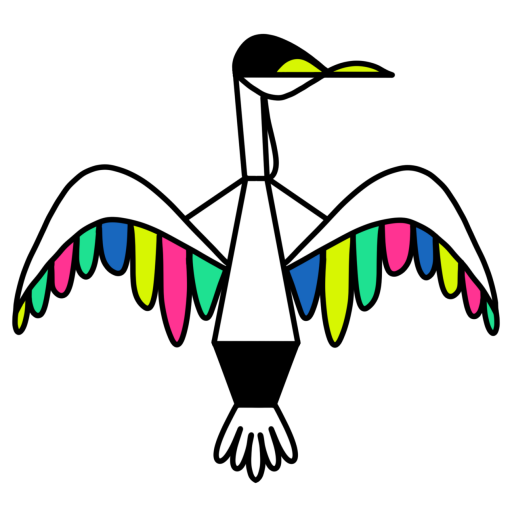Henry the cormorant - Art as a symbol for plastic in the bellies of animals
- 04/12/2022
It is already known that our waterways are plagued by plastic waste, but what are the consequences for animals? To reflect this and the other problems our waterways are facing, we made an artwork that we installed at the end of November 2022 on the quay of the canal in Brussels. In the video you can see how the artwork took shape on site.
Lots of plastic can be found in our waterways and oceans, big and small pieces, if it’s not plastic packaging then it’s microplastics. Millions of tons of plastic end up in our oceans every year. This has a serious impact on aquatic life: turtles, dolphins and whales get hurt or trapped, and birds and other animals mistakenly see the plastic for food. But we don’t have to look that far. The canal in Brussels is also used by various animals, the cormorants being one of them. They can often be seen in and around the canal, using it as a source for food. They dive into the water and hunt for fish. While hunting, they can swallow all kinds of plastic waste, large pieces or microplastics.
The artwork depicts a cormorant drying its wings on the quay after a dive in the canal. The belly of the cormorant is a waste bin in which passers-by can throw their waste. The symbolism is strong, because of the pollution of our waterways, trash ends up in the stomachs of animals just as passers-by will throw it in Henry’s belly. This plastic can give the animals a very unpleasant life and eventually kill them. But it doesn’t stop there, the plastic ends up on our plates again through the food chain, at least for those who eat fish or seafood.
Henry is partly built with reuse material, which you can see when you look deep into his eyes, in reality you are looking at two skateboard wheels. The artist who brought Henry to life is LGH Henry (Instagram: lgh_artist), we did indeed name the artwork after the artist. He makes all his works of art from recycled material such as old wooden furniture and everything he can find. Henry lives in a small village in Wallonia where a small river flows through and where you can observe cormorants every day. The first time we called him he immediately replied that he already had a stuffed cormorant for a long time and wanted to do something with it, we had a match.








The participants of our kayaking trips have been fishing plastic from the canal for a long time and we have long wanted to use this plastic to prevent other plastic waste from ending up in the water. That’s why we started recycling it ourselves to make colorful feathers for Henry the cormorant. All the feathers are made from plastic waste fished from the canal. The plastic was recycled by Mathilde’s small start-up Plastic Factory. She was very enthusiastic to use her expertise for this symbolic and awareness raising project. We hope that the artwork will appeal to many passers-by and we hope that it will contribute to a more circular society with less waste.
We have to deconstruct the normal of today, it is not normal that supermarket shelves are still completely filled with single-use packaging, it is not ok that we are bombarded every day through all kinds of media with advertisements for products with single-use packaging and it is not ok that the industry continues to oppose stricter environmental measures such as the deposit system for cans and plastic bottles.
The artwork was financed by the Vlaamse Gemeenschapscommissie, the City of Brussels and Fonds voor Natuur bij ons (WWF) and was inaugurated on Friday 25 December in the presence of Brussels alderman Arnaud Pinxteren, Molenbeek alderman Gloria Garcia Fernandez, Brussels member of parliament Lotte Stoops and representatives of the Vlaamse Gemeenschapscommissie, Bral, Brussels Environment, the Sewer Museum, Port of Brussels, BPC Group, Molembike, Saintklet, Coördinatie Zenne, the Canal It Up team and sympathizers. Everyone present could attach a feather to the artwork. Henry the artist could not be there, but another artist, architect and visionary was present with whom we already worked on a few projects, Luc Schuiten. He arrived in his self-designed tricycle with which he reduces the emissions of all his voyages to zero. There is room for two in the tricycle and it is powered by pedals together with an electric battery. Below you can see pictures of the inauguration day.
